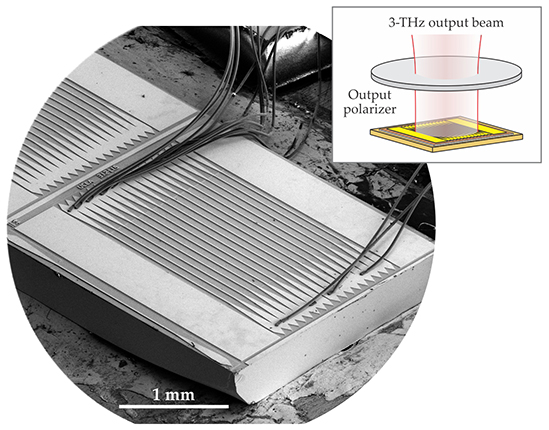A quantum cascade laser gets a geometric makeover
DOI: 10.1063/PT.3.3070
Achieving a high-quality beam—one whose profile is near Gaussian and as narrow as diffraction allows—can be a challenge in semiconductor laser design. That’s especially true in the few-terahertz frequency regime, an elusive part of the electromagnetic spectrum just below the reach of most optical technologies and just above the reach of electronics.
No natural material has an open bandgap small enough to emit coherent photons below tens of terahertz. The quantum cascade laser (QCL), one of the few devices that can operate at a few terahertz, relies on stacked, two-dimensional layers of semiconductors, which create quantum wells that act as gain material. The spatial confinement of electrons in the wells splits the conduction band into discrete subbands, separated by energies as small as a few meV, depending on the semiconductor-layer thickness (1 THz corresponds to about 4 meV).
Transitions between the subbands are at the heart of the QCL (see the article by Federico Capasso, Claire Gmachl, Deborah Sivco, and Alfred Cho, Physics Today, May 2002, page 34
To provide better collimation, a group led by UCLA’s Luyao Xu and her thesis adviser, Benjamin Williams, altered the usual geometry of a QCL to create a larger aperture. 1 In their device, shown here, a single waveguide is replaced by an array of them that emits out of plane. Each waveguide is composed of a 10-µm-thick stack of gallium arsenide and gallium aluminum arsenide layers sandwiched between copper electrodes; the waveguide ends are tapered to quench in-plane lasing. Furthermore, the waveguide width is carefully chosen so that each effectively acts like an elongated, surface-emitting antenna. With their subwavelength (90-µm) spacing, the antennas collectively form a 1.5 mm × 1.5 mm metasurface that amplifies radiation and reflects it vertically.

A quantum cascade laser ordinarily lases in-plane, from within a long, thin waveguide filled with quantum wells. Fashioned from an array of such waveguides (thin strips), this metasurface emits out of plane, thanks to the waveguides’ tapered ends, which quench in-plane lasing. The metasurface also serves as a mirror that can both amplify and reflect terahertz radiation. With a second mirror, or output polarizer, added 6 mm away, the two surfaces form an external cavity (inset) that can lase 3-THz photons. (Adapted from ref.

To complete the device, the team placed a wire-grid polarizer 6 mm away and parallel to the metasurface, as sketched in the inset. At terahertz frequencies, the output polarizer behaves like a mirror with a tunable reflectivity. Together the two surfaces form a new, external cavity that lases at its resonance frequency—in this geometry, 2.9 THz. And thanks to the array’s large area, the beam’s divergence—about 4° by 5°, measured at full width half maximum—is lower, and its profile more symmetric, than the emission from any previous terahertz QCL.
Polarization flips
The team’s approach—turning a waveguide laser geometry into a so-called vertical-external-cavity surface-emitting laser (VECSEL) geometry—isn’t new. It’s a common solution for improving beam quality among visible and near-IR semiconductor lasers. But the VECSEL approach was thought impossible for QCLs, whose intersubband transitions couple only to an electric field polarized perpendicular to the plane of the quantum wells. That polarization is in the same vertical direction that the beam is supposed to travel in a VECSEL.
In the new work, Xu, Williams, and their colleagues realized that the metal edges of each antenna would bend the horizontal electric field of any normal- incidence photons by 90° and thereby satisfy the QCL selection rule. The photons become loosely trapped between the metal cladding layers and are amplified as they interact with the subbands in the quantum wells. The antenna structures likewise bend outgoing photons’ field by 90°, which recovers their horizontal polarization.
The new device’s geometry and large cross section offer further advantages. With 17 antennas packed together and receiving the same reflected light from an output polarizer, the laser is easy to lock into a single-cavity mode whose shape, polarization, and spectral properties can be controlled through the design of the metasurface and external cavity. What’s more, the beam power is scalable. So far, Williams and his team have generated beams of a few milliwatts—a respectable output. To increase the output power, they could lithographically add more antennas.
“We’ve shown the VECSEL configuration yields good power with a great beam,” Williams says. “Our goal is to demonstrate that it yields great power in a great beam.”
References
1. L. Xu et al., Appl. Phys. Lett. 107, 221105 (2015).https://doi.org/10.1063/1.4936887




